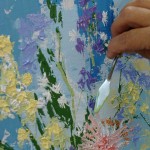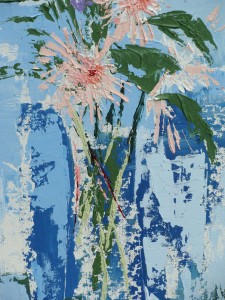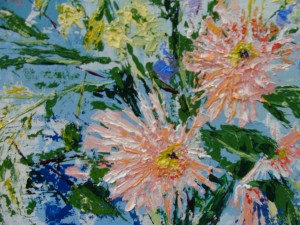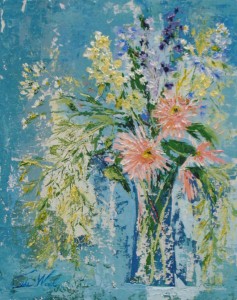I’ve always loved to watch Tisha Wood paint. Her moves (made with a knife) are unpredictable and full of surprises. Her right-brained method of working keeps me alert and delighted.
Subscribers: click on the post title to see view post on your browser.
Choosing a background color for a painting
Tisha begins her paintings by laying color onto the background with a knife held nearly flat. She doesn’t use the color of the actual background. For Tisha, colors are emotional entities that call out for relationships with other colors.
Lillian – I’ve always been mystified by how you arrive at your backgrounds. Can you describe the process that led to choosing to paint a blue background?
She began to explain that she studies the subject until she “starts to see colors”. Here is what she said about this piece…

Tisha Wood using a palette knife to paint in acrylics. This painting was done entirely with a knife.
Tisha – All of the flowers and greenery in this vase are very airy. This subject has a lot of air and delicateness.
If you look at these particular flowers, they are designed by nature so that the petals are almost like pieces of thin rice paper laid on each other – almost like lace.
Everything going on here is lacy – Even the large flowers.

Early stage of Tisha Wood’s acrylic bouquet (detail) Enlarge to see layering at this stage. Think about how it got this far: the white is the white of the canvas. The dark blue is scraped onto the canvas. The medium and light blue were mixed and laid down revealing the vase shape.
With the structure and pastel colors of the bouquet, I wanted to work off the blues of the room, which are everywhere. I even noticed the blues in the paint boxes.
I knew that the blues would work to set the vase strongly within the canvas and yet allow all of the very delicate work of nature in the vase to come forward.
You couldn’t do the same vase with a dark or heavy or strong background.
L- Yes, blues are in this room, but all the other colors are as well. Would you have done it in something other than blue, if you’d been in a different mood?
T – Yes, it would have been as beautiful in some soft cream colors with a hint of caramel or brown. But it would have given the piece an entirely different feeling. It would have been heavier.
L – When it first come to you that you were going to use blue, was it an intellectual decision, a feeling tone, or something else?
T- More of an emotion. The vase itself is emotional. The largeness and strength of the glass vase represents, in form and stature, a presence – a strong, tall, solid presence. And the arrangement itself is quite large, some would call it an impressive arrangement, but even with the shape and the form and the size, the statement of the bouquet is delicate.
The blues would let it be the focal point, would let it have stature, but still let every individual flower be delicate.
Working a painting
T – You can get to a point where you’re not having a relationship with the subject anymore and keep painting just to get on with it. That creates a disrespect for the subject which I don’t like.
(knifing light yellow onto the sprays of foliage) It takes awhile to discover what hue I missed to take the piece where it needs to go. And then I find it. And now it’s coming together.
Completing a painting
T- I’m done.
L- What makes you think the painting is done?
T- I believe that I’ve gotten as much life out of it as possible. It’s done; I feel it, I see it. I could go into it multitudes of times but doesn’t need it. It’s breathing life right now, and I have to walk away.
A one-woman show of Tisha’s paintings opens on Sept.22, 2012 at the Villa Gaspari Ramelli in Corsica. Tisha is currently featured in the Journal de la Corse (see excerpt below) and has been on French TV and radio.






BRAVO! …and a huge congratulations to Tisha! I have enjoyed painting with her sooo much over the past 4 years or so. She has been a huge asset to our group and a huge influence in how some of my style is developing. She is also a wonderful person that encourages us all…and I love her as a friend. I am blessed to know Tisha! Thanks for the interview, Lillian–it’s great!
Tisha and Lillian – To think I watched Tisha paint this! I felt her energy and rapport with those flowers – the immediacy of her experience. Each stroke is so alive. I am making my way through the review, every word in French. Bravo Tisha!